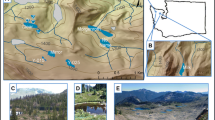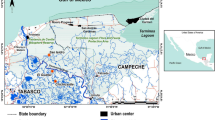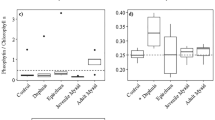Abstract
The Mackenzie River Delta, a floodplain system in the western Canadian Arctic contains approximately 45,000 lakes used by resident and migratory fish, aquatic birds, and mammal populations, which are critical resources for aboriginal peoples. Our results show the Mackenzie Delta is a remarkably productive aquatic ecosystem, not out of place relative to other large river floodplains and unusually productive for its Arctic latitude. Along with other such deltas of north flowing rivers to the Arctic Ocean, it represents a critical habitat of high productivity to support dependent consumers. Our results also showed a consistent under-saturation of CO2 in lake waters of the delta, co-occurring even with high concentrations of dissolved organic carbon, and indicating P:R greater than 1 during the open water period. In less turbid lakes, abundant macrophytes provide a considerable surface area for supporting production of epiphyton, but epiphyton production is constrained strongly by macrophyte shading, when macrophyte biomass is high. Despite this, epiphyton represented a greater supply of non-macrophyte algal carbon than phytoplankton, and thus explains why benthic algae may be a more important food source for primary consumers than phytoplankton, except in the most turbid systems. Most importantly, the high autotrophic production in the Delta lakes relative to nearby lakes on the arctic tundra suggests the extended ice-free season of the floodplain lakes and their landscape setting on, and replenishment by, nutrient-rich river sediments, is the strongest influence on aquatic production levels.







Similar content being viewed by others
References
Anema C, Hecky RE, Fee EJ, Nernberg D, Guildford SJ. 1990a. Water chemistry of some lakes and channels in the Mackenzie Delta and on the Tuktoyaktuk Peninsula, N.W.T., 1985. Can Data Rep Fish Aquat Sci 726: vii+73.
Anema C, Hecky RE, Himmer S, Guildford SJ. 1990b. Water chemistry of some lakes and channels in the Mackenzie Delta and on the Tuktoyaktuk Peninsula, N.W.T., 1986. Can Data Rep Fish Aquat Sci 729: v1+63.
Armstrong, N., D. Planas & E. Prepas. 2003. Potential for estimating macrophyte surface area from biomass. Aquat. Bot. 75:173-179.
Bootsma, H.A., R.E. Hecky, R.H. Hesslein, & G.F. Turner. 1996. Food partitioning among Lake Malawi nearshore fishes as revealed by stable isotope analyses. Ecology 77:1286-1290.
Bootsma HA, Hecky RE. 2001. Initial measurements of benthic photosynthesis in Lake Malawi. In: M. Munawar M, Hecky RE. Eds. The Great Lakes of the World:Food-web and integrity. Ecovision World Monograph Series, p 31–45
Boylen, C.W. & R.B. Sheldon. 1976. Submergent macrophytes: growth under ice cover. Science 194: 841-842.
Carson, M.A., J.N. Jasper & F.M. Conly. 1999. Riverine sediment balance of the Mackenzie Delta, Northwest Territories. Hydrol. Proc. 13:2499-2518.
Cole, J.J., N.F. Coraco, G.W. Kling, & T.K. Kratz. 1994. Carbon dioxide supersaturation in the surface waters of lakes. Science 265:1568-1570.
Coyne, P.I. & J.J. Kelley. 1974. Carbon dioxide partial pressure in arctic surface waters. Limnol. Oceangr. 19:928-938.
del Giorgio, P.A., J.J. Cole, & A. Cimbleris. 1997. Respiration rates in bacteria exceed phytoplankton production in unproductive aquatic systems. Nature 385:148-151.
del Giorgio, P.A., & R.H. Peters. 1994. Patterns in planktonic P:R rations in lakes: Influence of lake trophy and dissolved organic carbon. Limnol. Oceangr. 39:772-787.
Eaton, J.W. & B. Moss. 1966. The estimation of number and pigment content in epipelic algal populations. Limnol. Oceangr. 11:584-596.
Emmerton, C. A., L.F.W. Lesack, and P. Marsh. 2007. Aquatic habitat composition, lake abundance, and potential water storage in the Mackenzie River Delta, western Canadian Arctic. Water Resour. Res. 43: W05419. doi:10.1029/2006WR005139, 2007.
Febria CM. 2005. Patterns of hydrogen peroxide among lakes of the Mackenzie Delta and potential effects on bacterial production. MSc Thesis, SFU, 124 p
Febria, C., L. Lesack, J. Gareis, and M. Bothwell. 2006. Patterns of hydrogen peroxide among lakes of the Mackenzie Delta, western Canadian Arctic. Can. J. Fish. Aquat. Sci. 63:2107-2118.
Fee EJ. 1984. Freshwater Institute primary production model user’s guide. Department of Fisheries and Oceans. Can Tech Rep Fish Aquat Sci 1328: v+36.
Fee E.J. 1990. Computer programs for calculating in situ phytoplankton photosynthesis. Can. Tech. Rep. Aquat. Sci. 1740:1-27.
Fee EJ, Hecky RE, Guildford SJ, Anema C, Matthew D, Hallard K. 1988. Phytoplankton primary productivity and related limnological data for lakes and channels in the Mackenzie Delta and lakes on the Tuktoyaktuk Peninsula, N.W.T. Can Tech Rep Fish Aquat Sci 1614: v+62.
Gareis JAL. 2007. Underwater irradiance attenuation and photobleaching of chromophoric dissolved organic matter in shallow arctic lakes of the Mackenzie Delta. MSc Thesis, SFU, 174 pp
Goldsborough, L.G. & G.G.C. Robinson. 1983. The effect of two triazine herbicides on the productivity of fresh water marsh periphyton. Aquat. Toxicol. 4:95-112.
Hamilton, S.K. & W.M. Lewis. 1987. Causes of seasonality in the chemistry of a lake on the Orinoco River floodplain, Venezuela. Limnol. Oceanogr. 32:1277-1290.
Hamilton, S.K. W.M. Lewis, Jr. & S.J. Sippel. 1992. Energy sources for aquatic animals in the Orinoco River floodplain: evidence from stable isotopes. Oecologia 89:324-330.
Hanson, P.C., D.L. Bade, & S.R. Carpenter. 2003. Lake metabolism: Relationships with dissolved organic carbon and phosphorus. Limnol. Oceangr. 48: 1112-1119.
Hansson, L.-A. 1990. Quantifying the impact of periphytic algae on nutrient availability for phytoplankton. Freshwater Biol. 24:265-273.
Healey, F.P., and L.L. Hendzel. 1980. Physiological indicators of nutrient deficiency in lake phytoplankton. Can. J. Fish. Aquat. Sci. 37:442-453.
Hecky, R.E., P. Campbell & L.L. Hendzel. 1993. The stoichiometry of carbon, nitrogen, and phosphorus in particulate matter of lakes and oceans. Limnol. Oceanogr. 38:709-724.
Hecky, R.E. & R.H. Hesslein. 1995. Contributions of benthic algae to lake food webs as revealed by stable isotope analysis. J N Am Benthol Soc 14:631-653.
Hecky, R.E. & P. Kilham. 1988. Nutrient limitation of phytoplankton in freshwater and marine environments: a review of recent evidence of the effects of enrichments. Limnol. Oceanogr. 33:796-822.
Hesslein, R.H. 1976. An in situ sampler for close interval pore water studies. Limnol. Oceanogr. 21:912-914.
Hesslein RH, Rudd JWM, Kelly C, Ramlal P, Hallard KA. 1990. Carbon dioxide pressure in surface waters of Canadian Lakes. Air-Water Mass Transfer. Selected Papers from the Second International Symposium on Gas Transfer at Water Surfaces. Minneapolis, MN, USA, September 12–14, 1990. American Society of Civil Engineers, New York, NY. p 413–31
Hobbie JE. 1980. Limnology of tundra ponds: Barrow, Alaska. Volume 13 of US/IBP Synthesis series, Dowden, Hutchinson and Ross, Inc. Stroudsburg, Pennsylvania
Hope, D., T.K. Kratz, & J.L. Riera. 1996. Relationship between pCO2 and dissolved organic carbon in northern Wisconsin lakes. J. Environ. Qual. 25:1442-1445.
Jassby, A.D., & T. Platt. 1976. Mathematical formulation of the relationship between photosynthesis and light for phytoplankton. Limnol. Oceanogr. 21:540-547.
Junk, W.J. 1997. Structure and function of the large Central-Amazonian river floodplains: Synthesis and discussion. p. 455–472, IN W.J. Junk (Ed.), The Central Amazon Floodplain: Ecology of a Pulsing System. Springer-Verlag.
Junk WJ, Bayley PB, Sparks RE. 1989. The flood pulse concept in river-floodplains systems. In Dodge DP, Ed. Proceedings of the International Large River Symposium. Can Spec Publ Fish Aquat Sci 106, 110–27
Kalff, J. & H.E. Welch. 1974. Phytoplankton production in Char Lake, a natural polar lake, and in Meretta Lake, a polluted polar lake, Cornwallis Island, Northwest Territories. J. Fish. Res. Bd. Can. 31:621-636.
Karlsson J. 2001. Pelagic energy mobilization and carbon dioxide balance in subarctic lakes in northern Sweden. PhD Thesis, Umea University, Umea, Sweden. ISBN 91-7305-093-8
Kling, GW. G.W. Kipphut, & M.C. Miller. 1991. Arctic lakes and streams as gas conduits to the atmosphere: Implications for tundra carbon budgets. Science 251:298-301.
Lesack, L., and P. Marsh. 2007. Lengthening plus shortening of river-to-lake connection times in the Mackenzie River Delta respectively via two global change mechanisms along the arctic coast. Geophys. Res. Lett. 34: L23404, doi:10.1029/2007GL031656.
Lesack, L.F.W., P. Marsh, & R.E. Hecky. 1998. Spatial and temporal dynamics in major solute chemistry among Mackenzie Delta lakes. Limnol. Oceanogr. 43:1530-1543.
Lewis, W.M., S.K. Hamilton, M.A. Lasi, M. Rodriguez, and J.F. Saunders. 2000. Ecological determinism on the Orinoco Floodplain. BioScience 50:681-692.
Liboriussen, L & E. Jeppesen. 2003. Temporal dynamics in epipelic, pelagic and epiphytic algal production in a clear and a turbid shallow lake. Freshwater Biol. 48:418-413.
Lorenzen, C.J. 1967. Determination of chlorophyll and phaeopigments: spectrophotometric equations. Limnol. Oceanogr. 12:343-346.
Mackay JR. 1963. The Mackenzie Delta area, N.W.T. Misc. Rep. 3: Geol. Surv. Can. 202 pp
Markager, S., W.F. Vincent & E.P.Y. Tang. 1999. Carbon fixation by phytoplankton in high Arctic lakes: implications of low temperature for photosynthesis. Limnol. Oceanogr. 44:597-607.
Marsh P, Hey M. 1988. Mackenzie River water levels and the flooding of delta lakes. NHRI Contribution # 88013
Marsh, P. & M. Hey. 1989. The flooding hydrology of Mackenzie Delta lakes near Inuvik, NT, Canada. Arctic 42:41-49.
Marsh P. & L.F.W. Lesack. 1996. The hydrologic regime of perched lakes in the Mackenzie Delta: Potential responses to climate change. Limnol. Oceanogr.41:849-856.
Marsh, P., L.F.W. Lesack, and A.C.B. Roberts. 1999. Lake sedimentation in the Mackenzie Delta, NWT. Hydrol. Process. 13:2519-2536.
Murphy J. & J.P. Riley. 1962. A modified method for the determination of phosphate in natural waters. Anal. Chim. Acta. 27:31-36.
Pipke KJ. 1996. Under-ice methane accumulation in Mackenzie Delta lakes and potential flux to the atmosphere at ice-out. MS Thesis, Simon Fraser University, 198 pp
Prairie, Y.T., D.F. Bird, & J.J. Cole. 2002. The summer metabolic balance in the epilimnion of southeastern Quebec lakes. Limnol. Oceangr. 47:316-321.
Ramlal PS, Anema C, Cummings E, Fee EJ, Guildford SJ, Hallard K, Hecky RE, Hesslein RH, Himmer S, Kling H, Mathew D, Nernberg D, Schindler E. 1991. Macrophyte and algal studies of some lakes in the Mackenzie Delta and on the Tuktoyaktuk Peninsula, 1985–1986. Can Data Rep Fish Aquat Sci xxx: v+86.
Ramlal, P.S., R.H. Hesslein, R.E. Hecky, E.J. Fee, J.M. Rudd & S.J. Guildford. 1994. The organic carbon budget of a shallow Arctic tundra lake on the Tuktoyaktuk Peninsula, N.W.T., Canada. Biogeochemistry 24:145-172.
Riera, J.L., J.E. Schindler, & T.K. Kratz. 1999. Seasonal dynamics of carbon dioxide and methane in two clear-water lakes and two bog lakes in northern Wisconsin, U.S.A. Can. J. Fish. Aquat. Sci. 56:265-274.
Robinson, G.C., S.E. Gurney & L.G. Goldsborough. 1997. The primary productivity of benthic and planktonic algae in a prairie wetland under controlled water-level regimes. Wetlands 17:182-194.
Rouse, W. M. Douglas, R. Hecky, A. Hershey, G. Kling, L. Lesack, P. Marsh, M. McDonald, B. Nicholson, N. Roulet & J. Smol. 1997. Effects of climate change on the freshwaters of arctic and subarctic North America. Hydrol. Proc. 11:873-902.
Shearer JA. 1978. Two devices for obtaining water samples integrated over depth. Can Fish Mar Serv Tech Rep 772: iv+9.
Shearer JA, DeBruyn ER, Declercq DR, Schindler DW, Fee EJ. 1985. Manual of phytoplankton primary production methodology. Can Tech Rep Fish Aquat Sci 1341: iv+58 p
Solorzano L. 1969. Determination of ammonia in natural waters by the phenol-hypochlorite method. Limnol. Oceanogr. 14:799-801.
Sparks, R.E. 1995. Need for ecosystem management of large rivers and their floodplains. BioScience 45:168-182.
Spears BM. 2002. Effects of nutrient limitation on heterotrophic bacterial productivity and edible phytoplankton biomass among lakes of the Mackenzie Delta. MSc Thesis, SFU, 159 pp
Spears, B. W. and L.F.W. Lesack. 2006. Bacterioplankton production, abundance, and nutrient limitation among lakes of the Mackenzie Delta (Western Canadian Arctic). Can. J. Fish. Aquat. Sci. 63:845-857.
Spencer, W.E. & R.G. Wetzel. 1993. Acclimation of photosynthesis and dark respiration of a submersed angiosperm beneath ice in a temperate lake. Plant Physiol. 101:985-991.
Squires M.M. & L.F.W. Lesack. 2001. Benthic algal response to pulsed versus distributed inputs of sediments and nutrients in a Mackenzie Delta lake. J. N. Am. Benthol. Soc. 20:369-384.
Squires M.M., L.F.W. Lesack & D. Huebert. 2002. The influence of water transparency on the distribution and abundance of macro-autotrophs among lakes of the Mackenzie Delta, western Canadian arctic. Freshwater Biol. 47:2123-2135.
Squires, M.M. & L.F.W. Lesack. 2002. Water transparency and nutrients as controls on phytoplankton along a flood-frequency gradient among lakes of the Mackenzie Delta. Can. J. Fish. Aquat. Sci. 59:1339-1349.
Squires M.M. & L.F.W. Lesack. 2003a. Spatial and temporal patterns of light attenuation and the roles of TSS, DOC, and chlorophyll as light attenuators among lakes of the Mackenzie Delta. Freshwater Biol. 48:1-20.
Squires M.M. & L.F.W. Lesack. 2003b. The relation between sediment nutrient content and macrophyte biomass and community structure along a water transparency gradient among lakes of the Mackenzie Delta. Can. J. Fish. Aquat. Sci. 60: 333-343.
Stainton M.P. 1973. A syringe gas-stripping procedure for gas chromatographic determination of dissolved inorganic and organic carbon in fresh water and carbonates in sediments. J. Fish. Res. Bd. Can. 30:1441-1445.
Stainton MP, Capel MJ, Armstrong FAJ. 1977. The chemical analysis of fresh water, 2nd edn. Can Fish Mar Serv Misc Publ 25: vii+166 pp
Schindler, D.W., H.E. Welch, J. Kalff, G.H. Brunskill & N. Kritsch. 1974. Physical and chemical limnology of Char Lake, Cornwallis Island (75 ºN lat.). J. Fish. Res. Bd. Can. 31:585-607.
Tank, S.E., L.F.W. Lesack, and R.H. Hesslein. 2009. Northern delta lakes as summertime CO2 absorbers within the arctic landscape. Ecosystems 12:144-157.
Tockner, K., F. Malard, and J.V. Ward. 2000. An extension of the floodpulse concept. Hydrol. Proc. 14:2861-2883.
Turner, M.A., E.T. Howell, M. Summerby, R.H. Hesslein, D.L. Findlay & M.B. Jackson. 1994. Changes in epilithon and epiphyton associated with experimental acidification of a lake to pH5. Limnol. Oceangr. 36:1390-1405.
Vadeboncoeur, Y., D.M. Lodge & S.R. Carpenter. 2001. Whole-lake fertilization effects on distribution of primary production between benthic and pelagic habitats. Ecology 82:1065-1077.
Vadeboncoeur, Y., Jeppesen, M.J.V. Zanden, H-H. Schierup, K. Christoffersen & D.M. Lodge. 2003. From Greenland to green lakes: Cultural eutrophication and the loss of benthic pathways in lakes. Limnol. Oceanogr. 48:1408-1418.
Welch, H.E. & J. Kalff. 1974. Benthic photosynthesis and respiration in Char Lake. Can. J. Fish. Aquat. Sci. 31:609-620.
Xenopoulis, M.A. & D.F. Bird. 1997. Effect of acute exposure to hydrogen peroxide on the production of phytoplankton and bacterioplankton in a mesohumic lake. Photochem. Photobiol. 66:471-478.
Acknowledgments
We appreciate the assistance provided by Amy Schultz, Chris Teichreb, and Andrea Reidel in the field and in the lab, and the technical and logistical support provided by Les Kutny and the staff at the Inuvik Research Centre. We thank William M. Lewis, Jr. and an anonymous reviewer for comments that improved the manuscript. We acknowledge generous logistic support from the Polar Continental Shelf Project Department of Energy, Mines, and Resources. Financial support was received from NSERC (DGP to L. L., PGS B and PDF to M.S.) and from the Northern Scientific Training Program, Department of Indian and Northern Affairs, and from the Northern Oil and Gas Action Program through the Department of Fisheries and Oceans, Central and Arctic Region.
Author information
Authors and Affiliations
Corresponding author
Additional information
Co-Author Contributions
Squires: Designed and led implementation of the 1997–1998 studies of the chain lake set; analysis of the 1997–1998 primary productivity data and of the 1985–1986 macrophyte and benthic algal primary productivity data; primary author.
Lesack: Wrote the grant applications and obtained the funding that supported the field work and analysis associated with the 1997–1998 studies of the chain lake set; overall supervision of the limnological studies of lakes in the Mackenzie Delta through the 1990’s, and up to the present; contributed to the intellectual content and writing of the paper.
Hecky: Designed and led implementation of the 1985–1986 studies of the three sill lake set studies; did initial analysis of CO2 flux data; supervised all field data collection of the 1985–1986 and preparation of data reports referenced in this MS.
Guildford: Data collection and initial assessment of the 1985–1986 three sill lake set phytoplankton, epipelon, epiphyton, and macrophyte data.
Ramlal: Investigator for 1986 study; performed CO2 measurements; edited various drafts.
Higgins: Co-wrote computer model for total autotrophic production; assisted with scoping of the manuscript, figures, and edited various drafts.
Electronic supplementary material
Below is the link to the electronic supplementary material.
Rights and permissions
About this article
Cite this article
Squires, M.M., Lesack, L.F.W., Hecky, R.E. et al. Primary Production and Carbon Dioxide Metabolic Balance of a Lake-Rich Arctic River Floodplain: Partitioning of Phytoplankton, Epipelon, Macrophyte, and Epiphyton Production Among Lakes on the Mackenzie Delta. Ecosystems 12, 853–872 (2009). https://doi.org/10.1007/s10021-009-9263-3
Received:
Revised:
Accepted:
Published:
Issue Date:
DOI: https://doi.org/10.1007/s10021-009-9263-3




